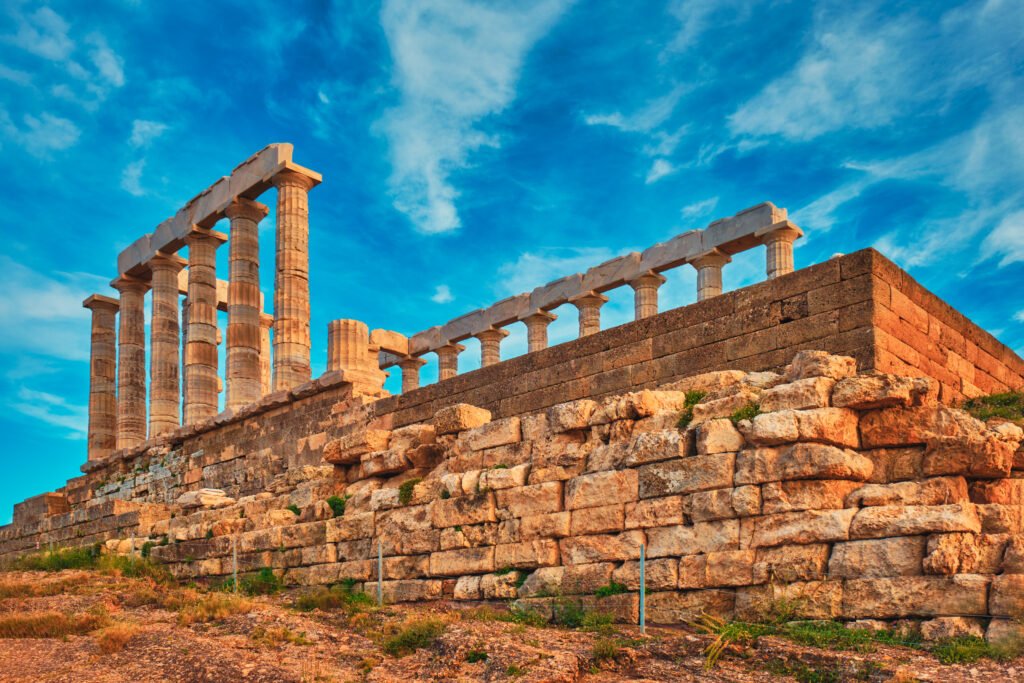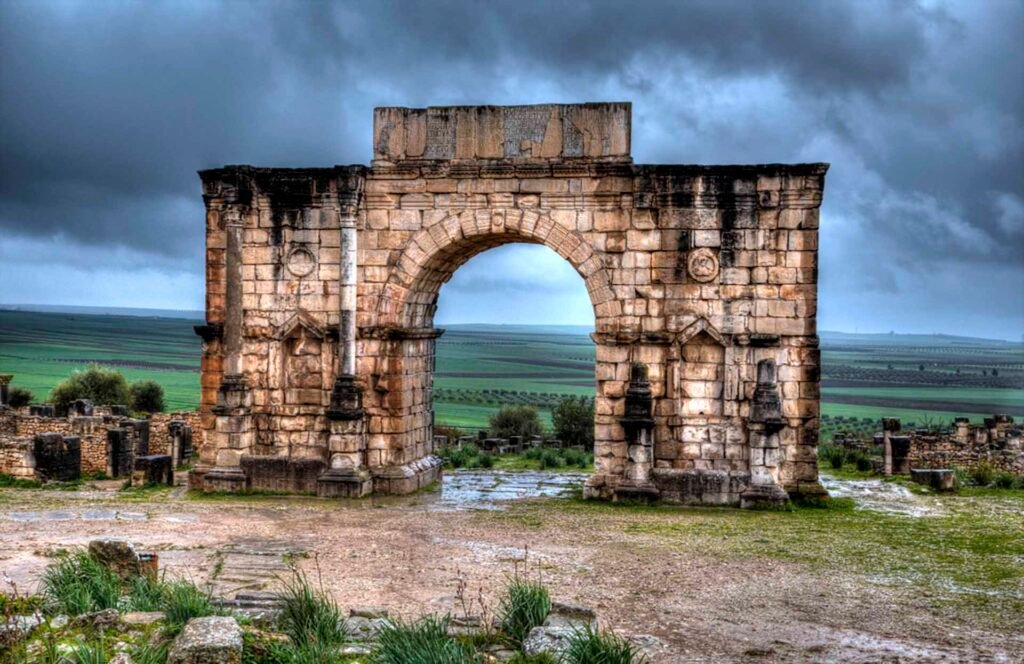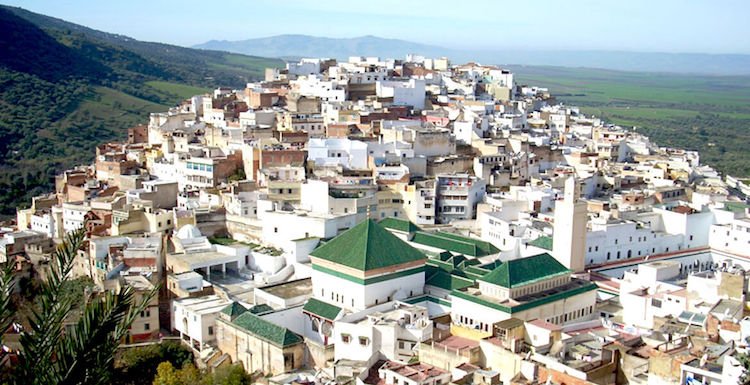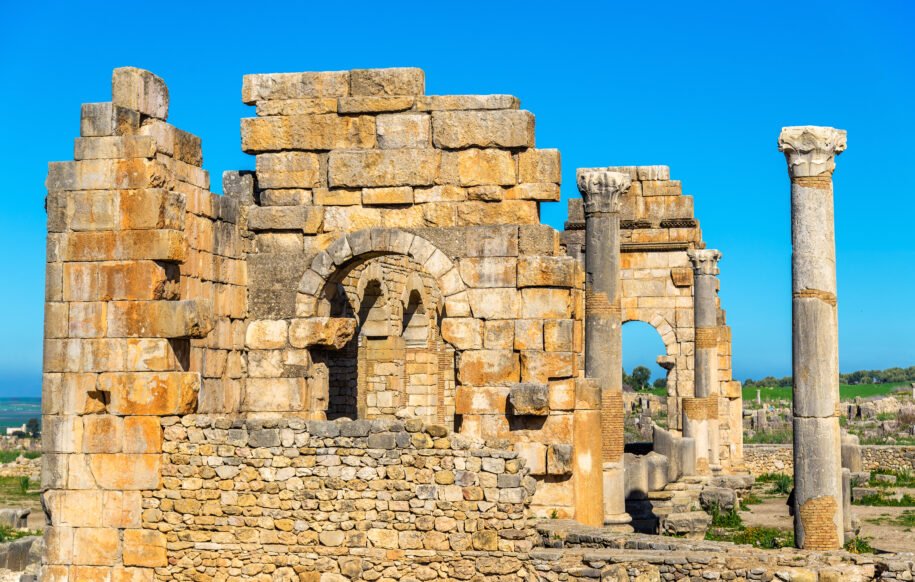If you have a passion for history and enjoy exploring ancient ruins, then Volubilis in Morocco is a must-visit destination. This remarkable archaeological site, located just outside Meknes, offers a fascinating journey into Morocco’s Roman heritage. As one of the best-preserved Roman cities in North Africa, Volubilis provides visitors with a rare opportunity to stroll through centuries-old ruins and admire stunning mosaics that have survived since the 3rd century B.C.
Visiting Volubilis is a rewarding day trip, especially from Fes or Meknes, and the site spans over 40 hectares, allowing plenty of space to discover. Highlights of the site include the majestic Triumphal Arch, the grand House of Orpheus, the Capitol, the Basilica, and the Baths of Gallienus. As you wander through the streets, you can feel the echoes of ancient Roman life, from public baths to residential homes, all framed by panoramic views of the surrounding countryside.
Whether you’re drawn to its historical significance or architectural beauty, a visit to Volubilis is an enriching experience for any traveler. Below is a complete guide to help you make the most of your visit to this UNESCO World Heritage site, including practical tips on how to get there, key landmarks to explore, and suggestions for a memorable experience at this exceptional Roman site in Morocco.
A Glimpse Into History: The Origins of Volubilis

The history of Volubilis dates back to the 3rd century B.C. when it was first established as a Berber settlement. However, its significance grew immensely when it became a Roman city in the 1st century B.C. under the reign of Juba II, the Roman-backed king of Mauretania. Juba II, an ally of the Roman Empire, transformed Volubilis into the capital of Mauretania, making it a hub of agriculture, trade, and culture.
The city flourished under Roman rule, with its population reaching an estimated 20,000 people. It became known for its production of olive oil, cereals, and wild animals, which were exported to other parts of the Roman Empire. The city continued to prosper throughout the 1st and 2nd centuries A.D., with many of its most impressive structures—such as the Triumphal Arch, the Basilica, and several houses adorned with beautiful mosaics—dating from this period.
However, the Roman Empire eventually withdrew from the region around 285 A.D., leaving Volubilis vulnerable to local Berber tribes. Over time, the city was abandoned, and it wasn’t until the late 1800s that archaeological excavations began, uncovering the remarkable ruins we can visit today. Volubilis was designated a UNESCO World Heritage Site in 1997, recognizing its outstanding representation of Roman architecture and urban planning.
How to Get to Volubilis in Morocco
Volubilis is conveniently located near two major Moroccan cities: Meknes and Fes. Most travelers visit Volubilis as a day trip from either of these cities, given its proximity and ease of access.
- From Meknes: Volubilis is only a 30-minute drive from Meknes. You can hire a private driver or take a grand taxi to reach the site. If you prefer public transport, you can catch a CTM bus from Meknes to Moulay Idriss, a town just 3 kilometers from Volubilis, and then either walk or take a petit taxi to the ruins.
- From Fes: If you’re staying in Fes, Volubilis is about a 1.5-hour drive away. Hiring a private driver for the day is the most convenient option. Organized tours are also available from Fes, which typically include a stop at Meknes and the nearby town of Moulay Idriss.
Driving yourself is also a possibility, as the site is well-signposted from the N13 road between Meknes and Moulay Idriss. Parking is available just outside the entrance to the archaeological site.
Exploring the Roman Ruins of Volubilis

Volubilis, Morocco’s largest and best-preserved Roman site, spans around 40 hectares, though only half of the area has been excavated. Serving as the capital of the Roman province of Mauretania between AD 40 and 285, it offers visitors a unique glimpse into the region’s ancient Roman heritage. In recognition of its historical importance, Volubilis was declared a UNESCO World Heritage Site in 1997, celebrating it as an outstanding example of a Roman colonial town.
As you explore Volubilis, you’ll be immersed in a variety of Roman structures, ranging from impressive public buildings to intricately decorated private homes. Key areas to visit include the Decumanus Maximus, the main street running through the ancient town, where you can imagine the bustling life of a Roman city. Not to be missed is the grand Triumphal Arch of Caracalla, which stands as a powerful symbol of Roman influence and architecture.
The site also boasts stunning mosaics, particularly in the House of Orpheus, where intricate artwork depicting scenes from Roman mythology has been remarkably preserved. These mosaics provide a window into the artistic sophistication of the time.
For those eager to dive deeper into the past, here are some of the must-see monuments and highlights:
The Triumphal Arch
The Triumphal Arch is one of the most iconic structures in Volubilis. Built in 217 A.D. to honor the Roman Emperor Caracalla and his mother Julia Domna, the arch stands at the entrance to the city, welcoming visitors with its imposing grandeur. The arch once marked the city’s main entrance, and it still stands today as a symbol of Volubilis’ Roman past.
The Decumanus Maximus
The Decumanus Maximus was the main street of Volubilis, running from the city gate to the Triumphal Arch. As you stroll along this wide, column-lined avenue, you can imagine how it once bustled with life as the central artery of the city. The street offered commanding views over the surrounding fertile plains, which played a crucial role in the city’s prosperity.
The Capitol and Basilica
The Capitol marked the beginning of the Decumanus Maximus and housed the city’s most important temple, likely dedicated to the Roman gods Jupiter, Juno, and Minerva. Adjacent to the Capitol is the Basilica, a grand structure partially reconstructed to give visitors an idea of its original size and beauty. Built in 217 A.D., the Basilica was used for legal proceedings and public meetings. Its towering white marble columns and large open spaces make it a highlight of any visit to Volubilis.
The House of Orpheus
One of the most famous private houses in Volubilis is the House of Orpheus, named after the beautiful mosaic that depicts Orpheus playing the lyre, surrounded by animals enchanted by his music. The mosaics in this house are some of the finest examples of Roman artistry found in Volubilis, featuring detailed scenes of mythology and daily life.
The House of the Ephebe
Another aristocratic home, the House of the Ephebe, contains notable mosaics, including depictions of Bacchus in a chariot drawn by panthers and scenes of athletes and acrobats. The artistry of these mosaics offers a fascinating glimpse into the culture and pastimes of the Roman elite.
The House of the Columns
The House of the Columns is named for its open courtyard, surrounded by a circle of columns. This partly reconstructed house once belonged to a wealthy Roman family, and some of the mosaics and artifacts found here are now displayed in the Archaeological Museum in Rabat.
The Baths of Gallienus
Public baths were an essential part of Roman life, and the Baths of Gallienus in Volubilis are a testament to this tradition. Built in the late 200s A.D., the baths include several well-preserved pools and pipelines. Visitors can still see parts of the original structure, offering insight into the engineering prowess of the Romans.
The Olive Presses
Volubilis was a major producer of olive oil, which was a lucrative export for the city. Scattered throughout the site, you’ll find the remains of several olive presses, some of which are still intact. These presses highlight the importance of agriculture to Volubilis’ economy and the city’s role as a supplier of goods to the broader Roman Empire.
Visiting Tips for Volubilis
Visiting Volubilis is an easy and rewarding day trip from Fes or Meknes. To make the most of your visit, consider the following tips:
- Timing: Visit in the morning or late afternoon to avoid the midday heat and to see the ruins bathed in the soft, golden light. These are also the best times for photography.
- Guides: While you can explore the site on your own, hiring a guide is highly recommended. Licensed guides are available at the entrance and can provide fascinating insights into the history and significance of the various ruins for 100-150 dirhams.
- What to Bring: Wear sturdy shoes, as the terrain can be uneven. Bring plenty of water, a hat, sunscreen, and sunglasses, as there is little shade at the site. Also, don’t forget your camera Volubilis is a photographer’s dream!
- Useful information (price, opening times, etc.): The entrance fee for the Roman site of Volubilis is 70 dirhams for adults, while children under 12 pay 30 dirhams. The site is open from 8 a.m. to 7:30 p.m. during the summer and from 8 a.m. to 5:30 p.m. in the winter. Guide services are available, but their rates are arranged directly with the guide. Parking is free, and a small restaurant is on-site for snacks and drinks. If visiting in summer, it’s recommended to wear a hat or cap, as there’s very little shade.
- Photography Permits: If you plan to take professional photos or use a tripod, you’ll need to purchase a photography permit for a small fee (about 5 dirhams).
Moulay Idriss Zerhoun – Morocco’s Holiest Town Near the Roman City of Volubilis

After exploring Volubilis, many visitors make a quick side trip to the nearby town of Moulay Idriss Zerhoun. Located just 3 kilometers from the ruins, Moulay Idriss is one of Morocco’s most sacred towns. It is the burial place of Moulay Idriss I, the founder of the Idrisid dynasty and the man who introduced Islam to Morocco in the late 8th century.
Though non-Muslims cannot enter the mausoleum of Moulay Idriss, the town is still worth a visit for its picturesque streets and panoramic views over the surrounding countryside. Wander through the town’s narrow lanes, stop at one of the many cafés for a mint tea, and soak in the peaceful atmosphere before heading back to Meknes or Fes.
Frequently Asked Questions About Visiting Volubilis
What is the best time of day to visit Volubilis?
The best time to visit Volubilis is in the early morning or late afternoon. This allows you to avoid the hottest part of the day while also enjoying the site in the best light for photography. Arriving about an hour before sunset can provide you with beautiful lighting for your photos and a cooler, more pleasant experience.
How much time do you need to explore Volubilis?
To fully appreciate Volubilis, plan to spend at least 2-3 hours exploring the ruins. This will give you enough time to see all the major highlights, including the Triumphal Arch, Basilica, and House of Orpheus, without feeling rushed.
Is there an entrance fee for Volubilis?
Yes, there is a small entrance fee of 70 dirhams for adults, while children under 12 pay 30 dirhams. to visit Volubilis. Additionally, if you want to take professional photos or videos, you’ll need to purchase a photography permit for 5 dirhams or a videography permit for 20 dirhams.
Can I visit Moulay Idriss on the same day as Volubilis?
Absolutely! Moulay Idriss is just a short drive (or walk) from Volubilis, making it a perfect addition to your day trip. Spend 30-60 minutes wandering the town’s winding streets and soaking in the atmosphere before heading back to Meknes or Fes.
Can I take children to Volubilis?
Yes, Volubilis is a family-friendly destination, and children can enjoy exploring the open space and ruins. However, keep in mind that the site is not particularly stroller-friendly due to uneven ground and rocky paths. It’s a good idea to bring water, sunscreen, and hats to protect children from the sun.
Can I bring a drone to Volubilis?
Drone use in Morocco is regulated, and flying a drone over Volubilis is generally prohibited without special permits from Moroccan authorities. It’s best to check the latest regulations and obtain necessary permits if required before bringing a drone to the site.
What should I wear when visiting Volubilis?
Comfortable, lightweight clothing and sturdy shoes are recommended, as you’ll be walking on uneven surfaces. If visiting in the summer, bring a hat, sunglasses, and sunscreen for protection from the sun. During cooler months, consider layering as temperatures can fluctuate throughout the day.
Conclusion
A visit to Volubilis offers a fascinating journey back in time to an era when the Romans ruled North Africa. Whether you’re an archaeology enthusiast, a history lover, or simply curious about Morocco’s past, Volubilis will not disappoint. With its remarkably well-preserved ruins, beautiful mosaics, and stunning setting, this ancient Roman city is a must-visit destination for anyone traveling through Morocco’s Meknes region.


Leave a Reply